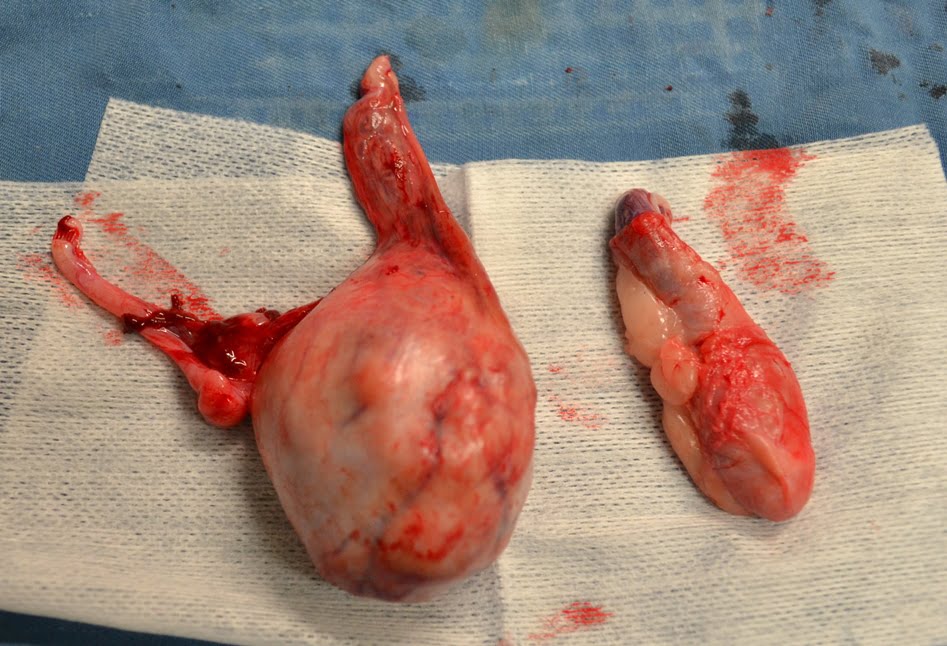Facts
For male dogs that are not neutered, testicular cancer is among one of the most common conditions. Cancer can be described as a growth of cells in or on the body that has blown out of control. There are three different types of testicular cancer. These are seminomas, sertoli cell tumours and interstitial cell tumours.
Seminomas will be seen as swelling of the inguinal, scrotum, abdomen, or testicle(s). It is not common for them to metastasize. Sertoli cell tumours show up as swelling in the scrotal or testicular region as well. These tumours may spread to the brain, lungs, abdomen, and thymus, but it is rare this happens. Likely the masses will create symptoms of hyperestrogenism. Outward symptoms will show up as anemia, symmetrical hair loss, attracting male dogs, enlarged prostate gland, nipples and mammary glands. Lastly are Interstitial cell tumours. These ones may be harder to catch early as they don’t often metastasize nor do they show many symptoms. For most dogs, they don’t usually cause an issue.
As with most cancers, early diagnosis is key as it can move quickly through the body.
Causes
Although the cause of the disease is largely unknown, for those dogs that have both or just one testicle that hasn’t descended, the risk of testicular cancer forming is much higher. Dogs in this category are at a high risk at developing malignant tumours, either Sertoli cell tumours or seminomas.
Doctors have been able to determine that one contributing factor to developing testicular cancer is the absence of cryptorchidism from the scrotum or testes. Another contributing factor is carcinogens found in the environment.
It is important to catch the disease early and treat it, as it can often spread to the liver and lungs and lymph nodes.
Prevention
The best way to prevent testicular cancer is to neuter the dog when it is still young before the cancer can ever have a chance of developing. If the dog is going to be bred, then neutering can take place once the breeding has been finished in order to prevent future development.
Symptoms
There are a number of symptoms to watch for and be aware of in regards to testicular cancer. Symptoms may include one or many of the following:
- a sore that doesn’t appear to be healing;
- difficulty defecating or urinating;
- a mass or lump that looks to be getting bigger;
- change in bladder or bowel habits;
- swelling of both or one testicle;
- infertility;
- scrotal enlargement;
- weight loss;
- loss of appetite;
- offensive odour;
- unexplained discharge or bleeding from any opening on the body;
- difficulty breathing;
- persistent stiffness;
- difficulty swallowing or eating;
- poor hair regrowth; and
- a change in behaviour.
Dogs at Risk
The dogs at the most risk of developing testicular cancer are those that have not been neutered. As well, dogs that have both or just one testicle that hasn’t descended are much more likely to develop the disease. Some breeds that appear to be at higher risk include: Afghan Hound, Boxer, Shetland Sheepdog, German Shepherd, and Weimaraner.
Testing and Diagnosis
In order to confirm a diagnosis for testicular cancer, the veterinarian will need to conduct a physical examination of the dog. A blood count and biochemistry will also be performed. During the physical exam the veterinarian will be looking for any mass or tumour on the testicles. Besides these tests, it is also common for xrays to be done on the chest and abdomen. These xrays will show if the tumour has spread.
An ultrasonography might be needed in order to give more information about malignant and nonmalignant conditions.
The veterinarian will sometimes want to perform a fine needle aspiration cytology. This is used to see if the tumour has metastasized to further regions of the body.
Treatment and Prognosis
Fortunately testicular cancer is a highly treatable disease that, if caught early, has a very good prognosis for recovery. Treatment is extremely easy in most cases as the dog just needs to be neutered to remove the cancer. The skin of the scrotal will likely be removed as well during surgery. This treatment is the ideal option for those dogs that have a localized tumour, which is the case for most dogs.
For dogs whose tumour has spread, treatment may also include chemotherapy or radiation therapy. Numbers show that only 1020% of cases involve the tumour spreading to other areas. A more guarded prognosis is given for these cases.
Once the cancerous growth(s) have been removed, most of the initial warning symptoms will disappear over time.
